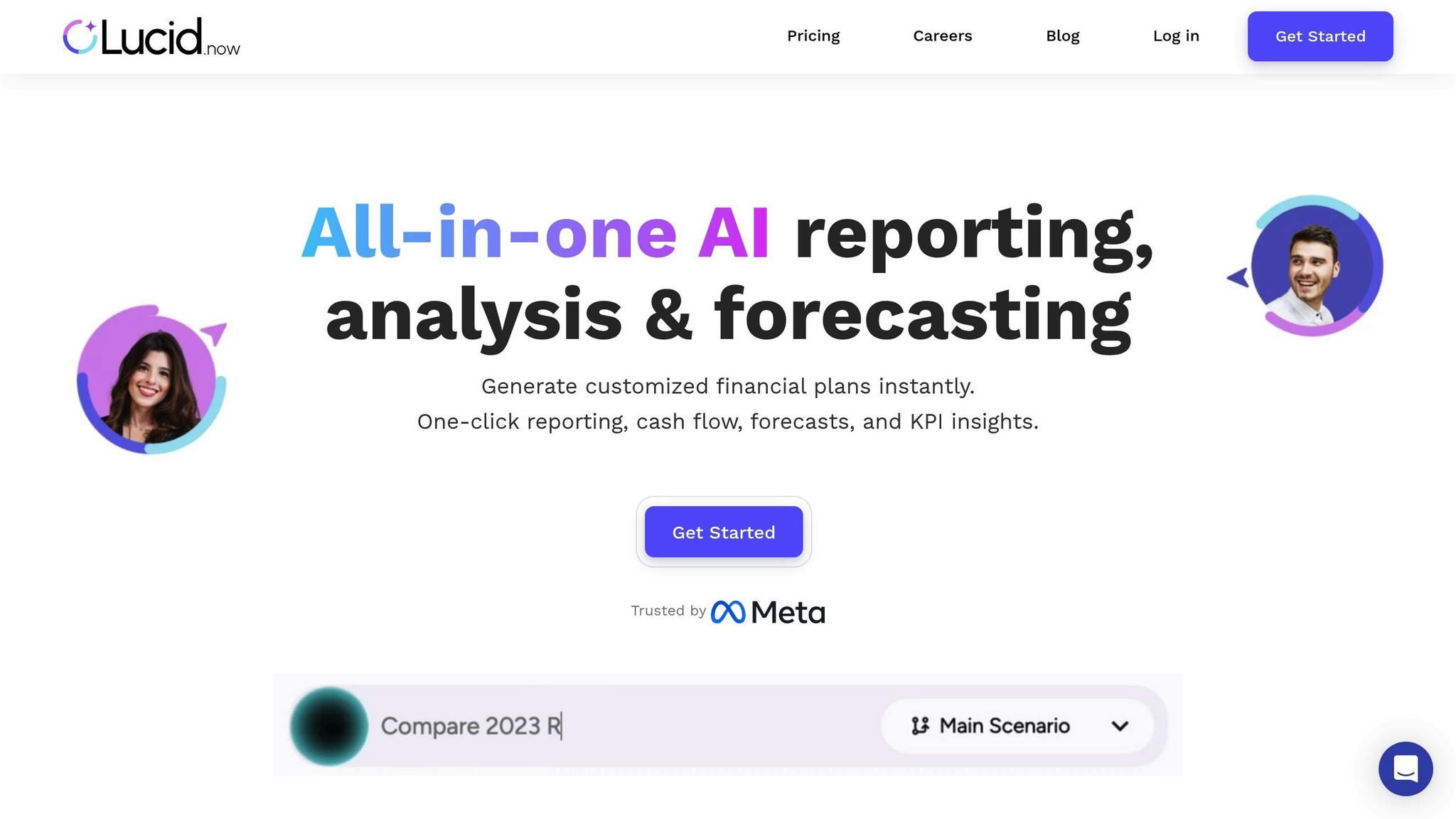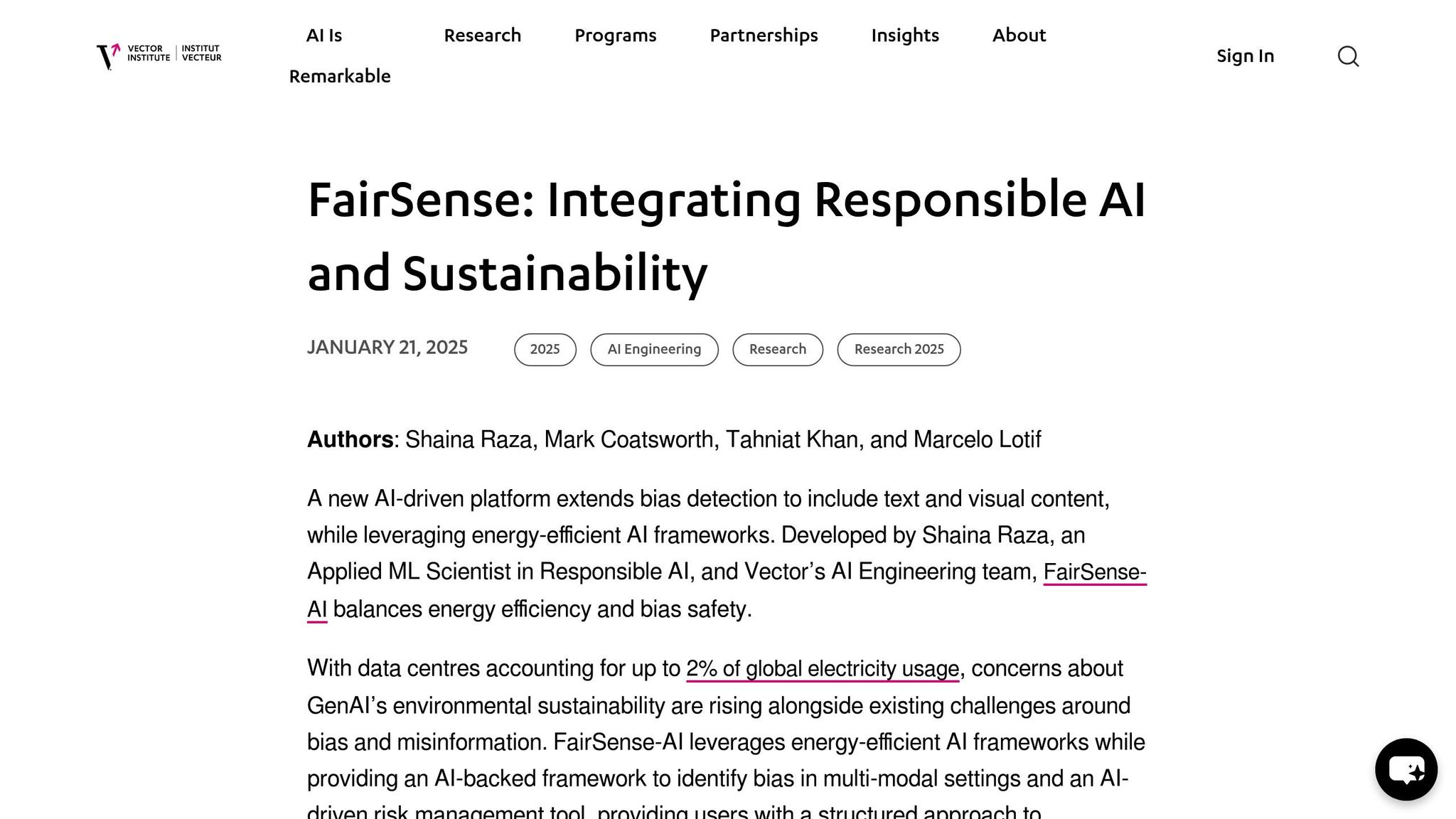AI can now help detect and reduce bias in financial decisions.
Group financial decisions are often influenced by biases like groupthink, confirmation bias, or overconfidence. AI bias detection tools analyze conversations, decision patterns, and data to identify and address these biases in real-time. This leads to better decisions, improved financial outcomes, and fewer compliance issues.
Key Benefits of AI Bias Detection Tools:
- Spot biases early: Identify unconscious patterns in discussions and data.
- Real-time alerts: Flag bias indicators during meetings or decision-making.
- Improved compliance: Automatically track and report regulatory adherence.
- Better outcomes: Reduce disparities and optimize resource allocation.
Examples of Tools:
- Lucid Financials: Real-time bias alerts and compliance tracking.
- FairSense AI: Focuses on demographic fairness and compliance.
- BiasCheck Finance: Combines NLP and machine learning for robust bias detection.
- EquiMetrics: Integrates bias detection into financial workflows.
- ClearView Analytics: Offers bias heatmaps and industry-specific benchmarks.
Quick Comparison:
| Tool | Key Features | Best For |
|---|---|---|
| Lucid Financials | Anchoring bias alerts, compliance tools | Financial governance and planning |
| FairSense AI | Demographic fairness, regulatory focus | Compliance-heavy industries |
| BiasCheck Finance | NLP + machine learning, robust integrations | Large-scale financial organizations |
| EquiMetrics | Workflow integration, real-time tracking | Everyday financial workflows |
| ClearView Analytics | Bias heatmaps, industry benchmarks | Data-driven financial analysis |
AI tools are transforming financial decision-making by making it more data-driven and less prone to human error. They’re easy to integrate into existing systems and provide measurable improvements in both fairness and performance.
The Ethics of Algorithmic Finance: Ensuring Fairness in ...
Common Biases in Group Financial Decisions
Group financial decisions can often be skewed by various biases, which can lead to flawed outcomes. Being aware of these biases is crucial when using AI tools to improve decision-making.
Groupthink: The push for agreement can stifle critical thinking, causing teams to ignore risks or alternative solutions.
Confirmation Bias: Groups tend to favor information that supports their existing beliefs and disregard evidence that challenges them, resulting in one-sided evaluations.
Anchoring: Early information heavily influences later judgments, making it harder to explore other financial planning options.
Status Quo Bias: Teams often stick to familiar methods, even when new strategies might produce better results.
Recency Bias: Recent events or data are given too much weight, leading to short-term decisions instead of balanced, long-term planning.
Authority Bias: Opinions from senior members can overshadow input from others, even when data-driven insights suggest otherwise.
Overconfidence: Groups may underestimate risks and overestimate potential rewards, especially in high-stakes financial decisions.
These biases often overlap and amplify each other, complicating decision-making processes. Recognizing them is a critical step in using AI tools to improve group financial decisions and reduce the impact of these distortions.
Core Functions of AI Bias Detection Tools
AI bias detection tools are designed to identify and minimize bias in financial decision-making. They combine advanced analytics with practical features to help ensure fair and balanced outcomes.
Natural Language Processing for Communication Analysis
These tools use Natural Language Processing (NLP) to review meeting transcripts, emails, and other digital communications. They look for patterns that may signal biases like confirmation bias or groupthink in financial discussions. For example, sentiment analysis can flag overconfidence during strategic planning sessions, helping teams identify potential blind spots.
Data Integration and Real-Time Analysis
Bias detection platforms connect directly to critical business systems, offering a comprehensive view of operations. Here’s how they integrate:
| Integration Type | Purpose | Key Benefits |
|---|---|---|
| Accounting Software | Tracks transactions | Highlights biased spending habits |
| HR Platforms | Analyzes team demographics | Promotes diverse input in decisions |
| Communication Tools | Maps decision-making | Identifies influence patterns |
| Email Systems | Tracks sentiment | Monitors tone in discussions |
These integrations ensure real-time analysis, allowing businesses to address biases as they arise.
Compliance Monitoring and Reporting
These tools automatically check for compliance with U.S. financial regulations, such as those set by FINRA. They create detailed audit trails with standardized timestamps and generate compliance reports tailored to regulatory requirements. A key focus is identifying disproportionate financial decisions that might indicate systemic bias.
"Use AI to surface 70% of potential issues through pattern recognition, but reserve 30% of analysis for contextual human review, particularly for edge cases involving cultural factors or emerging market conditions." - Dr. Alicia Tan, FINRA advisor
Quantitative Bias Detection
Statistical analysis plays a key role in spotting disparities in financial decisions. Recent results include:
- A 34% reduction in gender-based lending disparities within six months.
- A 93% improvement in fairness metrics using advanced algorithms.
- An 89% precision rate in detecting bias clusters in financial models.
In addition to these insights, tools offer live monitoring during financial discussions. Features include:
- Real-time diversity metrics of decision participants.
- Sentiment analysis of ongoing arguments.
- Historical success rates of similar past decisions.
- Automated alerts for potential bias indicators.
Performance Tracking
Bias detection tools measure their effectiveness using specific metrics, such as:
- Variance in decisions across demographic groups (goal: less than 5% variation).
- False positive rates for bias alerts (industry standard: 12-18%).
- Time-to-detection for emerging bias patterns.
- Compliance audit pass rates (aiming for 95% or higher under CFPB standards).
These metrics highlight the tools' impact. For instance, 78% of financial institutions reported fewer compliance violations within six months of adopting these systems.
1. Lucid Financials

Lucid Financials showcases how specialized AI tools can embed bias detection directly into financial workflows.
Bias Detection Methods
Lucid Financials employs machine learning algorithms to pinpoint cognitive biases in financial decision-making. The platform evaluates historical financial data and flags potential biases. It also examines qualitative inputs, like investor updates and meeting notes, to identify language patterns that may indicate bias.
"Lucid's real-time anchoring bias alerts represent a paradigm shift in fiscal governance", says Dr. Emily Tran from MIT Behavioral Finance Lab.
These capabilities are further enhanced by integrations with key financial systems.
System Integrations
Lucid Financials connects with major business tools to improve bias detection:
| Integration Type | Bias Detection Capability | Impact Measurement |
|---|---|---|
| QuickBooks | Spots anomalies in spending patterns | Improves accuracy of financial insights |
| Payroll Systems | Highlights discrepancies in compensation data | Identifies issues like a 12% gender pay gap |
| Banking Platforms | Tracks transactional data for bias signals | Speeds up resolution of identified biases |
Decision Analysis Tools
Lucid Financials doesn't just detect biases - it also helps teams make fairer decisions.
The Scenario Simulator encourages teams to explore multiple outcomes, reducing optimism bias. Meanwhile, the Benchmark Checker flags deviations, such as customer acquisition costs (CAC) exceeding industry norms by more than 15%, which may indicate false consensus bias.
Compliance Features
Lucid Financials simplifies unbiased reporting with automated compliance tools. It generates detailed audit trails and preformatted reports, showing how bias alerts led to revised decisions and better allocation of resources. According to a study, companies using Lucid Financials cut regulatory penalties by 38% compared to manual processes.
For example, a Series B SaaS company analyzed its $2.5M marketing budget using the platform. The AI flagged recency bias, revealing that 73% of the funds were focused on channels with strong Q4 2024 performance but poor annual ROI. Following the tool's recommendations, the company redirected $800K to higher-performing channels, leading to a projected $4.1M boost in Annual Recurring Revenue.
Lucid Financials provides a comprehensive approach to identifying and addressing biases, helping teams make fairer financial decisions.
2. FairSense AI

FairSense AI focuses on identifying bias in financial decision-making, particularly in areas like regulatory compliance and demographic fairness. Its approach is built on advanced methods to uncover and address bias effectively.
Bias Detection Methods
The platform uses natural language processing (NLP) and image analysis to detect hidden biases. For example, a 2024 case study revealed that women-led startups faced a 23% higher rejection rate, based on a cross-analysis of decision metrics and demographic data.
System Integrations
FairSense AI connects seamlessly with major financial systems using pre-built connectors:
| Integration Type | Key Features | Performance Metrics |
|---|---|---|
| QuickBooks Online | Real-time transaction analysis | 89% faster bias audits |
| Oracle NetSuite | Automated compliance tracking | 97% faster CFPB documentation |
| Salesforce CRM | Demographic context analysis | 63% reduction in approval disparities |
Decision Analysis Tools
The Decision Playback module offers real-time bias heatmaps and monitors how stakeholders influence decisions at each stage. It also includes scenario simulations to test bias-adjusted parameters. This tool has been instrumental in reducing gender-based pricing disparities by 41% over six months in commercial lending portfolios. Additionally, its three-tier validation system has cut false alerts by 76% compared to earlier versions.
Compliance Features
The platform's Regulatory Sentinel feature leverages up-to-date compliance libraries to streamline documentation for over 38 regulatory standards, including NYC Local Law 144 and the EU AI Act. A Tampa-based credit union reported eliminating racial bias in small business loan approvals within 11 months. The tool also reduced documentation time for CFPB audits by 97% and ensured compliance with EEOC and OFCCP guidelines.
3. BiasCheck Finance
BiasCheck Finance, created as part of the Federal Reserve's Fair Credit Initiative, helps identify hidden biases in group financial decisions. This approach has already been implemented successfully by three of the top five U.S. commercial banks.
How Bias Detection Works
The platform uses a two-step process: natural language processing (NLP) to analyze meeting transcripts and machine learning models trained on historical financial data. Together, these tools detect statistical anomalies and cognitive biases that might affect decision-making.
"Their dual-layer validation system - statistical anomaly detection paired with cognitive bias frameworks - creates a robust shield against both conscious and unconscious financial decision flaws", says Dr. Alicia Tan, a behavioral economist at Stanford, in the Harvard Business Review (January 2025).
For example, during a Series B funding round for a California-based tech startup, 73% of discussions focused on investor sentiment. This caused them to overlook 12% of year-over-year R&D cost projections. When bias mitigation was applied, the competitiveness of the term sheet increased by 19%.
This detection process is further enhanced by the platform’s ability to integrate with major financial systems.
System Integrations
BiasCheck Finance connects easily to popular financial systems using prebuilt connectors:
| Integration Type | Key Features | Processing Capability |
|---|---|---|
| QuickBooks Online | Budget approval analysis | Real-time monitoring |
| Microsoft Dynamics 365 | Spending pattern detection | 1.2M decisions/hour |
| Oracle NetSuite | Custom API access | Full dataset analysis |
Tools for Decision Analysis
Beyond detecting biases, BiasCheck Finance includes tools to analyze and improve decision-making. For example, the Scenario Weighting Analyzer helps identify when teams place too much emphasis on certain factors. In one case, a team overvalued market trends by 40% compared to customer data during expansion planning. Another feature, Historical Pattern Matching, compares current decisions to a database of over 10,000 anonymized financial decisions, making it easier to spot unusual reasoning patterns.
Compliance Features
The platform also simplifies compliance with U.S. regulations like SOX Section 404 and SEC disclosure requirements. It provides detailed audit trails and tracks key compliance elements:
| Compliance Element | Tracking Metric | Retention Period |
|---|---|---|
| Participant Input | 0–100 bias probability score | 7 years |
| Model Versions | Full history documentation | 7 years |
| Decision Patterns | XBRL-formatted reports | 7 years |
BiasCheck Finance reduces proxy bias detection time by 78%, ensures SOC 2 Type II security, and supports NASDAQ Rule 5605(f) diversity disclosures.
sbb-itb-17e8ec9
4. EquiMetrics
EquiMetrics takes a practical approach to improving financial decision-making. By integrating directly with existing financial systems, it embeds bias detection into everyday financial workflows. This tool pulls critical financial data and highlights potential biases during routine reviews, helping teams address them as they arise. The result? A smoother process for identifying and reducing bias in group financial decisions.
5. ClearView Analytics
Bias Detection Methods
ClearView uses natural language processing (NLP) to scan transcripts and documentation for biases like confirmation bias and groupthink. Its proprietary algorithm compares financial projections against 12 industry-specific bias indicators, such as anchoring effects in budget forecasts. For instance, in Q3 2024, ClearView identified that a Fortune 500 manufacturer's acquisition review devoted 89% of its focus to synergy projections but just 6% to cultural integration costs. This highlighted the presence of optimism bias.
Up next, see how ClearView connects with key financial tools for real-time bias tracking.
System Integrations
ClearView connects via API to tools like QuickBooks Online and Excel, enabling real-time bias detection. A 2024 case study showed that a Seattle-based fintech startup reduced departmental budget disparities by 37% after implementing these integrations.
Decision Analysis Tools
ClearView's Bias Heatmap offers a visual summary of detected bias indicators:
| Bias Type | Detection Method | Measurement Approach |
|---|---|---|
| Revenue Projection Overconfidence | Comparison with sector benchmarks | Defaults to 95% confidence intervals |
| Recency Bias | Emphasizing recent market events | Variance analysis |
Compliance Features
ClearView also ensures regulatory compliance alongside its bias detection capabilities. The platform automatically generates audit trails that meet SEC Rule 17a-4 requirements. It includes SOX Section 404 controls for decision documentation and offers customizable disclosure templates for Reg FD compliance. Security measures include AES-256 encryption and SOC 2 Type II-certified servers hosted in AWS US regions. Following its FDIC cybersecurity examination in January 2025, ClearView now includes automatic PII redaction and role-based access controls aligned with FFIEC guidelines.
Tool Features and Limits Comparison
Lucid Financials offers a range of features designed to streamline financial management and decision-making:
| Feature/Capability | Lucid Financials |
|---|---|
| Core Bias Detection | Provides instant financial plans and neutral scenario comparisons |
| Integration Options | Works smoothly with QuickBooks, payroll platforms, and banks |
| Decision Support | Includes tools for fundraising, team growth, and investor updates |
| Performance | Speeds up financial processes by as much as 100 times |
| Scalability | Suitable for small teams to large enterprises |
| Price Range | Starts free, with options for enterprise-level needs |
These features highlight the platform's ability to simplify and accelerate financial management tasks.
Key Performance Indicators
Lucid Financials leverages AI to support fast, impartial decision-making. Its ability to integrate with existing systems and adapt to different organizational sizes makes it a practical choice for diverse teams.
Integration Capabilities
The platform connects directly with QuickBooks, payroll systems, and banking institutions, ensuring financial data is always up-to-date. This integration allows teams to make decisions based on real-time insights.
Scalability Considerations
With pricing options that start at zero and scale to enterprise solutions, Lucid Financials can adapt as your organization grows. It maintains reliable bias detection and financial oversight, regardless of team size or complexity.
How to Use AI Bias Detection Tools
Data Integration and Setup
Start by connecting your financial data sources to the AI bias detection tools. This ensures the system has access to accurate and up-to-date financial information, which is crucial for monitoring and analyzing decision-making patterns effectively.
Training Your Team
Training your team is essential for successfully using these tools. Focus on two key areas:
-
Practical Bias Recognition and Tool Usage
- Use hands-on exercises to show how financial bias can impact outcomes.
- Practice creating financial plans and comparing different scenarios.
- Teach team members how to interpret AI-generated insights.
- Show them how to use industry benchmarks to evaluate results.
-
Data Quality Protocols
- Set clear standards for data accuracy.
- Schedule regular audits and validation processes to ensure the data remains reliable for AI analysis.
A well-prepared team makes it easier to incorporate these tools into everyday operations.
Implementation Success Stories
"Keeping track of my finances used to be overwhelming, but now it's much simpler. The platform is well-organized and easy to navigate." - Erez Lugashi, Founder and CEO of Abilisense
"Lucid has made it incredibly easy to track spending, plan ahead, and handle our growth. It's straightforward and effective. Managing my finances has become much easier with this platform. It's user-friendly and efficient, saving me a lot of time and effort." - Aviv Farhi, Founder and CEO of Showcase
These examples highlight how successful implementation can make financial management simpler and more efficient.
Best Practices for Ongoing Use
| Area | Recommended Practice |
|---|---|
| Data Review | Conduct weekly data quality checks |
| Team Updates | Hold monthly training refreshers |
| Performance Monitoring | Track bias detection accuracy quarterly |
| System Updates | Apply new features as they become available |
| Compliance Checks | Perform monthly regulatory reviews |
Measuring Implementation Success
Once your team is trained and the tools are in place, track success through key metrics like:
- Speed of decision-making
- Accuracy of forecasts
- Number of bias incidents identified
- Team adoption rates
- Time saved in financial planning
"As our company grows, budgeting and cash flow management have become crucial. The features provided are essential and have greatly streamlined these processes for us." - Luka Mutinda, Founder and CEO of Dukapaq
Continuous Improvement
To keep improving, focus on:
- Collecting feedback from users
- Staying updated on industry trends
- Refreshing training materials regularly
- Tweaking implementation processes as needed
- Adjusting workflows based on performance data
Conclusion
AI tools now provide real-time insights and automated bias detection that traditional methods often overlook. These tools bring measurable advancements to financial decision-making by offering precise, data-backed solutions.
Feedback from leaders underscores the impact of these tools:
"Keeping track of my finances used to be overwhelming, but now it's much simpler. The platform is well-organized and easy to navigate." - Erez Lugashi, Founder and CEO of Abilisense
Organizations leveraging AI bias detection have reported several key benefits:
- Faster financial planning with fewer errors
- Increased confidence in decisions supported by reliable benchmarks
- Better identification and correction of systemic biases
- Stronger collaboration across teams
These advantages not only improve day-to-day decisions but also strengthen long-term financial strategies.
By regularly monitoring and updating these tools, businesses can stay aligned with evolving financial and regulatory environments. Features like real-time alerts and integrated analyses ensure that bias detection frameworks remain effective and adaptable to changing needs.
The path forward in financial decision-making lies in continuing to integrate AI, ensuring tools are consistently updated to detect and address biases effectively.
FAQs
How can AI tools identify and address biases in group financial decision-making?
AI tools can analyze group financial decision-making processes by identifying patterns, inconsistencies, or anomalies that may indicate bias. These tools use data-driven algorithms to evaluate decisions based on historical data, industry benchmarks, and predictive modeling.
Some common types of biases they can detect include confirmation bias (favoring information that supports pre-existing beliefs), groupthink (conforming to group consensus without critical evaluation), and anchoring bias (relying too heavily on initial information). By highlighting these biases, AI tools help teams make more objective, informed, and fair financial decisions.
What are the main advantages of using AI tools to detect bias in financial decision-making?
AI tools designed to detect bias in financial decision-making offer several key benefits. First, they help identify and mitigate unconscious biases within group decisions, ensuring fairer and more equitable financial outcomes. This is particularly important when making high-stakes choices like budget allocation, investment strategies, or team scaling.
Second, these tools analyze large datasets objectively and provide data-driven insights, reducing the influence of human error or subjective judgment. By doing so, they enhance the accuracy and transparency of financial planning processes.
Lastly, integrating AI bias detection tools into your workflows can improve decision-making efficiency, saving time and resources while fostering trust in the financial strategies developed.
How can businesses effectively implement AI tools to detect and address bias in their financial decision-making processes?
To successfully implement AI tools for detecting and addressing bias in financial decision-making, businesses should start by clearly defining their goals and identifying specific areas where bias might occur. This ensures the AI solution is tailored to their unique needs.
Next, ensure seamless integration by choosing tools that are compatible with existing financial systems, such as accounting software or payroll systems. Platforms that offer real-time insights and integration capabilities can streamline this process.
Finally, provide proper training for team members to understand how to use the tools effectively. Regularly evaluate the system's performance to ensure it continues to meet organizational goals and remains aligned with ethical standards.


